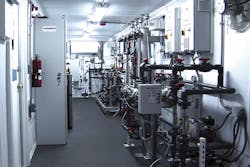Water professionals are seeking innovative approaches to address water supply challenges associated with population growth, drought, and environmental protection.
In California, two high profile projects are demonstrating the effectiveness of ozone-enhanced biofiltration for potable water reuse treatment facilities. In the first project, Pure Water San Diego (PWSD) is the city’s phased, multiyear program to demonstrate technology to produce a safe and sustainable high-quality water supply. The WateReuse Research Foundation (WRRF) commissioned a study (11-02) in partnership with the Upper San Gabriel
Valley Municipal Water District (USGVMWD) to evaluate various treatment trains incorporating ozone-enhanced biofiltration.
Scope
The PWSD program is expected to result in a water purification facility capable of producing up to 30 million gallons per day (mgd) of purified water by 2021. The long-term goal, producing 83 mgd—one-third of San Diego’s future drinking water supply—is scheduled for 2035. In addition, the USGVMWD is part of a team involved in WRRF’s project 11-02, evaluating alternative treatment trains for potable reuse, including the ozone-enhanced biologically active filtration.
PWSD has purchased demonstration units for long-term evaluations. The USGVMWD has already performed a pilot test of the system as part of WRRF’s research project to demonstrate that treatment trains alternative to the traditional membrane approach can successfully treat recycled water to potable water standards.
The USGVMWD and San Diego’s Pure Water Program are evaluating Leopold’s ozone-enhanced biologically active filtration Oxelia offering on the pilot scale for potable reuse projects.
Xylem’s Leopold Oxelia ozone-enhanced biofiltration System combines the treatment synergy of ozone oxidation and biologically active filtration into a single process solution.Ozone oxidation breaks down recalcitrant organic carbon to make it biodegradable. Then, naturally occurring microbes attach to a fixed bed filter and provide free aerobic biological treatment of the partially oxidized organic carbon. A centralized control system optimizes the ozone dose based on real time TOC monitoring to minimize energy consumption.
Solution
PWSD. The City of San Diego’s North City Water Reclamation Plant has a 1.5-mgd ozone/biological activated carbon (O3/BAC) system that is providing pretreatment to membrane filtration (MF), reverse osmosis (RO),
and ultraviolet-advanced oxidation process (UV-AOP), which produces one mgd of product water. This treatment train—O3/BAC/MF/RO/UV-AOP—is currently being considered in a project that will deliver purified water to the Miramar Reservoir.
USGVMWD believes that indirect potable reuse via groundwater recharge through surface spreading basins is the most promising option to supplement its potable water portfolio. Furthermore, USGVMWD would like to implement advanced wastewater treatment to improve the quality of the tertiary effluent intended for spreading. Due to the significant costs of full advanced treatment (i.e., MF, RO, and advanced oxidation by UV and hydrogen peroxide), USGVMWD is evaluating alternative treatment trains, including ozone and BAC, which can provide sufficient treatment for water reuse through surface spreading. To support this evaluation, USGVMWD and Trussell Technologies conducted a pilot study investigating total organic carbon (TOC) removal by a treatment train of ozone, BAC, and soil aquifer treatment (SAT). The goal of this research was to minimize the TOC concentration in the product water.
With an O3:TOC ratio of 1.0, a 39-min empty bed contact time in BAC filter, and a 56-day hydraulic residence time for SAT; the secondary effluent TOC concentration was lowered from 6.3 to 1.4 mg/L, a reduction of 78 percent that would help minimize the blend water required for compliance with California’s groundwater recharge TOC requirements.
A separate pilot study conducted by Trussell Technologies tested a variety of unit processes incorporating ozone and BAC for the treatment of wastewater effluent. This study demonstrated significant water quality and disinfection benefits enabling compliance with public health criteria for chemical and microbiological constituents. Additionally, the combination of ozone and BAC provided significant operational benefits for downstream low-pressure membranes.
Results
As demonstrated by these pilot studies, ozone enhanced biofiltration has the potential to make significant contributions to potable reuse treatment and provide an alternative for utilities looking to minimize power consumption and secondary brine management requirements. These advantages create the opportunity for utilities to consider potable reuse that would normally find RO-based treatment trains prohibitive for implementing potable reuse.
With the Leopold Oxelia ozone-enhanced biologically active filtration system, dangerous compounds are destroyed before they have a chance of being concentrated in an RO brine reject stream.
Editor's Note: Scranton Gillette Communications and the SGC Water Group are not liable for the accuracy, efficacy and validity of the claims made in this piece. The views expressed in this content do not reflect the position of the editorial teams of Water & Wastes Digest, Water Quality Products and Storm Water Solutions.
